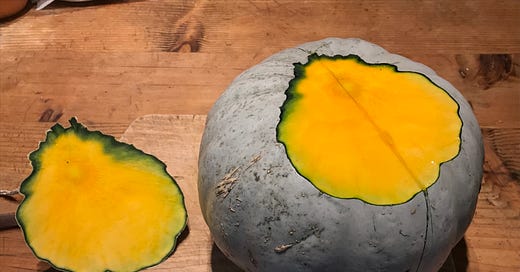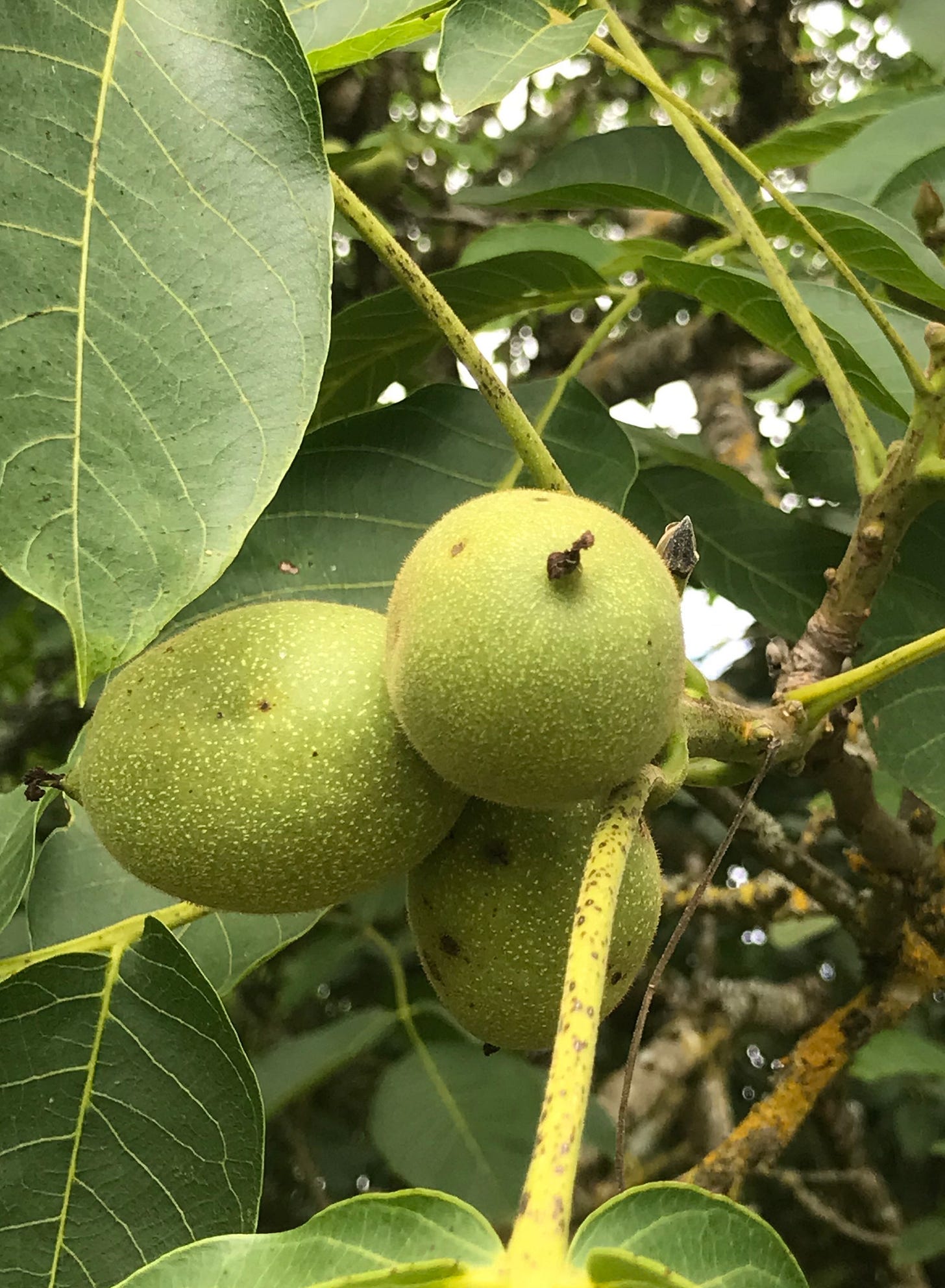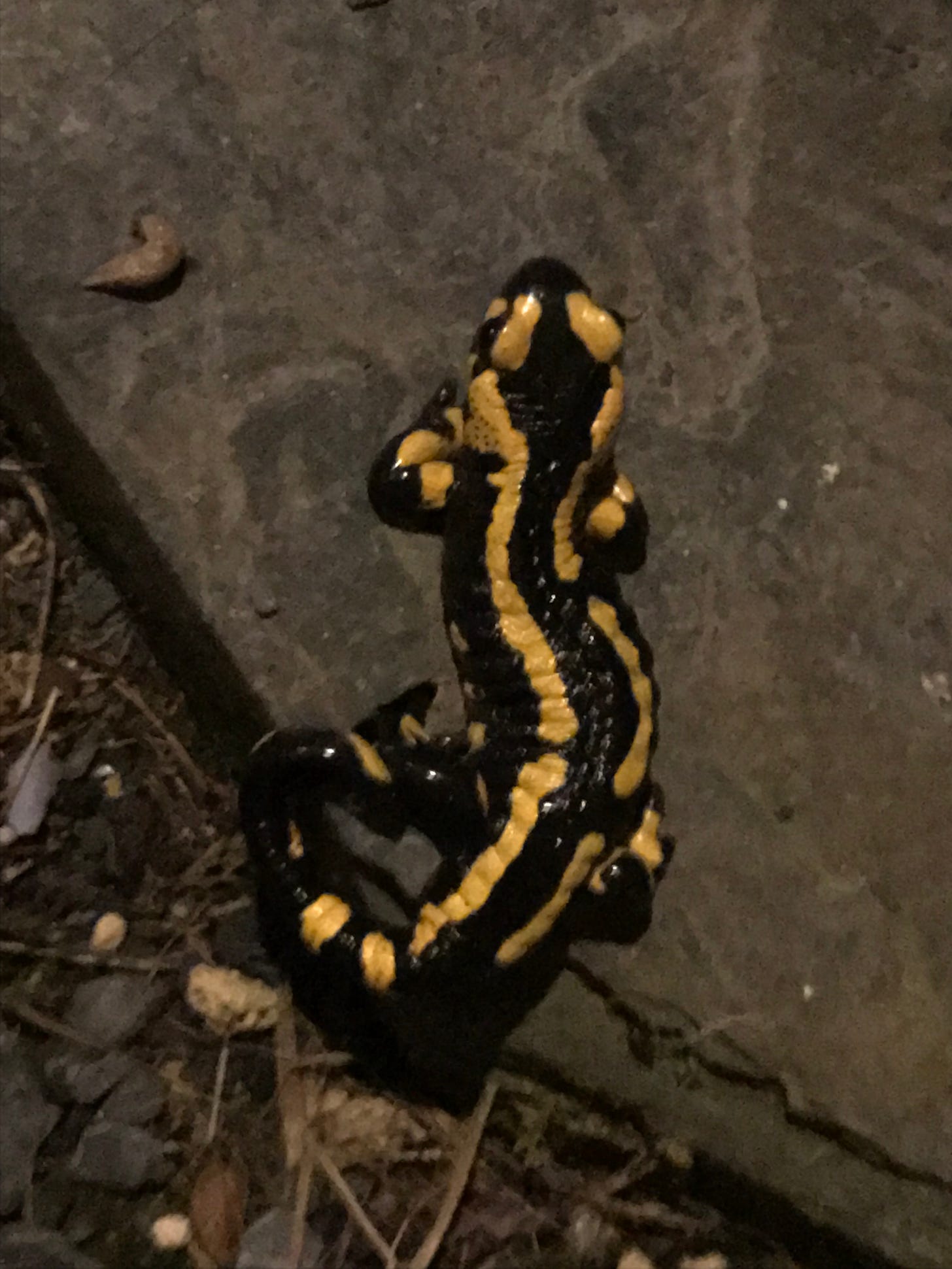Sowing, digging, harvesting, thinking about meaning
As I’ve been sowing, I’ve been thinking about meaning (as you do. As they say.) More in a minute.
I’ve been planting those saffron crocus bulbs, and digging up another one of the sweet potato plants. It plus one of its ‘runners’ has produced a phenomenal crop. The first/last that I dug was Beauregard: pink skinned and orange-fleshed, delicious. The trouble with this one, a Murakami, with striking purple skin and white flesh that makes it look poisonous, is that I don’t like it very much, which is a shame given the quantity.
I also need to find out how to store sweet potatoes (my internet still depends on a snatched hour in a cyber café): I suspect in the jute sacks in which we’re also storing the potatoes – once they’re dry. We could, too, bake and freeze them, as I might squash, of which we still have a vast number. Good job the dogs also eat both as part of their diet. However, we came so close to losing our whole frozen harvest in the powercuts after the hurricane that I feel slightly twitchy about this method of preserving. Once again, I long to be off-grid, and I know that means drying or bottling a harvest rather than freezing; and that brings its own set of problems.
TM has managed to prepare a fairly large area for our food crops, and with a couple of notable exceptions (the loss of 16 large tomato plants to blight, red peppers that did nothing, even in the polytunnel, exactly 2 aubergines each roughly the size of a lemon, and a strangely-stunted crop of onions, with black tops) we’ve had a wonderful harvest for our first year.
A couple came and spent the first week of October with us, at harvest-time. Christina and I go back decades, to when I taught a novel-writing course in Plymouth that she attended about 30 years ago. She has been a regular participant on many courses of mine now, and I consider her a dear friend. She and her husband Jerry came out to help us on the land, in exchange for food and board. We had an intensely hot week, and our friends excelled themselves in the amount of work they put in.
As always, there’s a synergy that happens when people work together. The four of us achieved so much more than the sum of our parts, so to speak. One of the many things they did was help us get the bean harvest in. We grow French beans: Cobra to eat green (or pod to store the little black beans, if there are too many to eat fresh); Borlotti, the pretty pink-striped beans, to freeze; green flageolets, ditto; and a bean new to us, a good substitute for butter beans, the Cocos de Paimpol, fat round creamy beans, also to freeze.
In a storm a couple of months ago about 60 of our 90 beanpoles, fully and heavily laden, went down like dominoes in the southwesterlies, and snapped. It took quite an effort to lift and ‘patch’ them with fencing stakes, ringed by rope to prevent the same thing happening again, and we inevitably lost a few plants. But not many: there was a still a good harvest. C and J spent the equivalent of a whole day sitting outside in sun at one of the tables and podding the lot so that I froze around 45 bags for our winter protein (along with the chestnuts). (So far it seems that, fortunately, despite our power being down for 4 days, they didn’t quite defrost enough to have to throw.)
If you are reading this, Christina, you were stars, both of you.
So for our first year of growing, albeit starting a little late, we have had (I said I was going to boast) in the weather northern France has offered us (perhaps not too different from southwest England: that is, extremes of heat and rain), rich crops of:
broad beans: green and red skinned (Karmaszyn; these are lovely),
red and white potatoes,
beetroot,
red and orange carrots,
squashes of 4 varieties,
green and yellow courgettes,
lots of climbing beans,
salad crops,
sweetcorn,
broccoli,
curly kale,
cavallo nero black kale,
rainbow chard,
purple sprouting broccoli (just beginning),
cabbages red and green,
swede,
leeks,
a small harvest of red, rose and yellow onions,
sweet potatoes,
rocket,
physalis (Cape gooseberry),
parsnips (just ready now),
all edged with nasturtiums as a kind of sacrificial crop for the cabbage white caterpillars, and because they are beautiful; blue-eyed borage by the ton; mint and marigolds.
We also had loads of ladybirds fly in to help with aphids.
And of course we also had apples, peaches, chestnuts and walnuts from the trees already here.
Wilderness or wasteland?
This morning, in more rain, we walk past the wildlife pond we’ve created at the bottom of the Home Meadow. We’re hoping it will be colonised by amphibians. We know there’s at least one salamander and a toad around: both tried to get in through the back door last month, as they did in the previous October.
We also have a tribe of (non-amphibian) hedgehogs, an occasional pine marten and a red squirrel or two. There’s an occasional fox around, and far far too many field voles for our root veg, though I like them in their own right, and they involuntarily support young foxes learning to hunt, and a healthy sparrowhawk, buzzard and owl population. I’m told there’s a French verb for that vertical up and down motion that a fox makes pouncing on a vole: ‘muloter’, from ‘mulot’, which means vole (I think). One of our dogs instinctively uses that action himself when on his favourite occupation, voleing.
There is still quite a bit of storm damage to clear up; too much for the bow-saw I was using yesterday on smaller branches (for that woodchipper; once again, C and J were invaluable in helping us prepare and chip a vast heap of fallen or pruned branches. Much of that chip has gone on the now-empty veg beds as winter mulch.)
Everywhere parasol mushrooms are springing up, late, mainly too sodden to eat. Scattered between them are the colourful (and highly toxic/hallucinogenic – see the ‘About’ page) – fly agaric, as in the photo below:
One of the wonderful things about what we’ve named the Home Meadow, a large area with many different features and habitats, is that we keep discovering more plants, shrubs and hidden things. (For instance, we didn’t know until we actually moved in that there was another small orchard, almost completely overgrown. We’ve liberated it, though mostly it’s cider apples. Maybe next year we’ll try making cider.)
Below the current veg bed that TM has created from meadow, there is what was once the previous owners’ veg plot, now like the orchard completely overgrown with a riot of wild plants.
I glance at it, as it is, with pleasure: I know it to be a very rich mosaic of habitat and biodiversity. We’ve been surprised by many red poppies. There are white campions, yarrow and mallow; masses of mint. There must be 100+ borage plants, many still in flower for the fews bees and butterflies that occasionally still appear in November sun. There are stands of nettles, and one or two coloured chard plants that must be all of 3 or 4 years old, for of course they can be left like a perennial; something I’m taking advantage of in my circular genius loci polyculture bed. The area boasts many seedheads, for the birds. I delight in this area.
So I’m startled when TM sighs and says ‘What a wasteland.’ It is he, clearly, who is doing the bulk of the hard work, and I know he is thinking of the time when, little by little, we will be reclaiming this to extend our vegetable-growing, and also to trial small areas of chickpeas, buckwheat and green lentils, for extra protein, and how much work that will take, mostly by him, probably by scythe.
In the main, he and I see eye-to-eye, but not always. It is hard to escape the mindset of land = productivity, and of course we all need to eat. A large part of our rationale for being here is to make a sustainable vegan micro-farm. This bit is also the most obvious area on which to continue our annual and perennial vegetable and grain/pulse growing (leaving aside orchards and forest gardening, of which more anon), and we are aiming to be as self-sufficient as we can be, and as I also say in the ‘About’ section, to provide excess should it be needed (‘Come the apocalypse’); and to leave something carefully-tended in a balanced way for whoever comes after us.
But this is far from a wasteland, from an other-than-human viewpoint. A large part of my own joy at being here is what we can do for the rest of the natural world.
Leaving something carefully-tended – which might mean leaving something not at all tended, for wildlife – for whoever comes after us. This sets me thinking, this afternoon, as I’m planting my precious saffron crocus bulbs.
That question of meaning
There is nothing like the ageing process to focus your mind on what really matters.
From time to time, often at the seasonal turning points of the year, in my own life, in my writing and in some of the groups I lead I ask the question about what it is that gives one’s life meaning. Of course, there are all the usual and significant sources of meaning, for almost all of us: family, friends, love relationships; passions, interests and activities; groups and communities; creativity, perhaps: the life of the imagination; for some, a life of service to Other; if one is lucky, a life well-lived in the sense of work one believes in that doesn’t contravene one’s values.
This last holds a key.
As I age I’m increasingly aware that what is most important for me (in addition to, etc) is a life lived in alignment with one’s (my) deepest values. That does, of course, presuppose knowing what they are at any one time, and I suspect they change over the course of a life. I find it’s worth regularly checking in and reassessing them – it’s never too late.
I like to think that as one ages one’s core purpose, the prompting of one’s own unique soul-calling, becomes clearer. It certainly becomes, if one lives the considered life, less negotiable.
For me, all the excess flesh has gradually been stripped off my various distractions and procrastinations (shame I can’t say the same in relation to my physical body!), leaving one key motif: how might I live as if utterly embedded, as I am/we are, in the vast web of life, an utterly interconnected part? This is my core value: trying to live it; talking about it on my courses and attempting to give people hands-on experience of what that might feel like; trying to write about it.
Working as a course and retreat leader, the last few decades mainly outdoors, and as someone initially trained in psychotherapy, I have seen over and over the healing power on humans of being outdoors with the rest of the natural world. People flourish when brought into deeper connection with it. Healing happens. It’s one of the most profound methods I know for bringing body and soul back together and into balance. ‘Nature therapy’ has been something I consciously facilitate when working with others.
And yet, and yet.
Increasingly, I have started to be uncomfortable with yet another example of our taking from nature: nature as a resource (once any living being or system is seen as a ‘resource’ it becomes a ‘thing’ to be exploited).
So what about focusing on what we can give to nature, rather than what we might take? What does this mean? How might it look? How might we shift our sense of connectedness into one where we are deeply embedded, a part of, not apart from and looking on from the outside?
A shift in perspective: an apprenticeship to the land
A large part of my own motivation for being here on this land in Brittany, and working with, tending, or in some places keeping our hands off the land in our care, is to live while causing as little harm as possible, on as many fronts as possible. Better, I’d like to make positive changes in relation to regeneration, working in harmony with the land, this land; apprenticed to it.
A decade or two ago I started to realise that truly nothing will change if we continue with the same mindset we as a species have used to destroy the earth. Of course the governments of the world need to change their viewpoint too, and fast; but that doesn’t let individuals off the hook: as so often, the solutions lie in both/and. It’s empowering, too, to make small changes in one’s life; to feel that there is something we can each do, no matter how small. Even tiny individual actions can make a big difference. I often think of anthropologist Margaret Mead’s words, which I’m quoting from memory here: ‘Never doubt that a group of committed citizens can change the world. Indeed, it’s the only thing that can.’
We really need to transform our viewpoint from the human-centred to the eco-centred; otherwise there is little chance of reversing the damage and destruction that we are perpetually imposing on the other-than-human world. I’m going to repeat that:
‘We really need to transform our viewpoint from the human-centred to the eco-centred; otherwise there is little chance of reversing the damage and destruction that we are perpetually imposing on the other-than-human world.’
I ask again what does this mean? And what does this mean for me, here, in practice?
As always, thank you for reading.
More next week – IF I have internet access…











:) An abundant harvest is such an achievement! And then, after that mountain of work is behind you, begins the mountain of work figuring out how to put it all away 🤣
"We really need to transform our viewpoint from the human-centred to the eco-centred; otherwise there is little chance of reversing the damage and destruction that we are perpetually imposing on the other-than-human world."